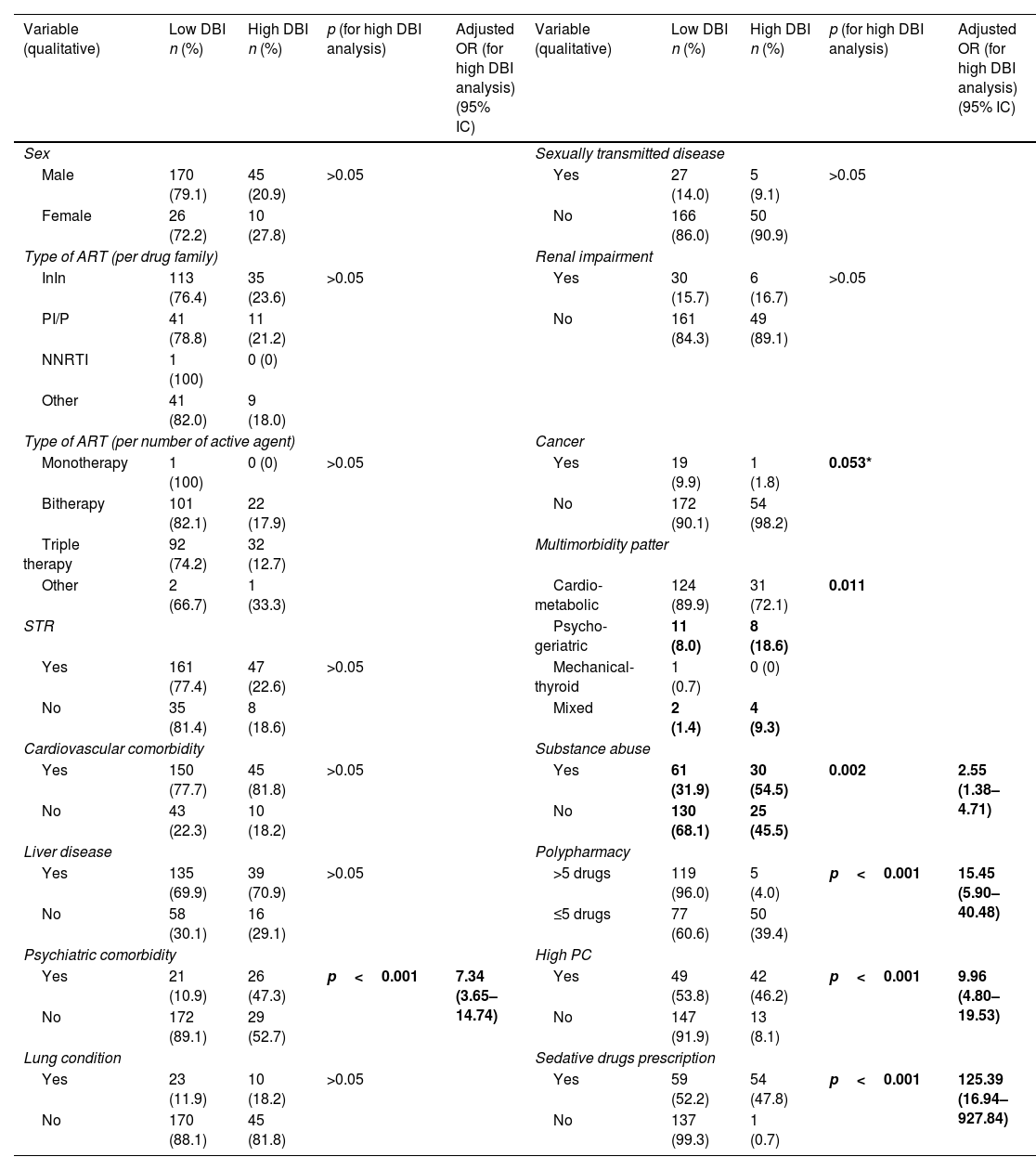To determine DBI and its relationship with polypharmacy and pharmacotherapeutic complexity (PC) in a cohort of PLWH over 50 years of age at follow-up of pharmacotherapy in a tertiary hospital.
MethodsObservational and retrospective study that included PLWH in active antiretroviral treatment over 50 years of age who have been followed up in outpatient pharmacy services. Pharmacotherapeutic complexity was estimated through Medication Regimen Complexity Index (MRCI). Collected variables included comorbidities, current prescriptions and its classification according to anticholinergic and sedative activity and associated risk of falls.
ResultsStudied population included 251 patients (85.7% men; median age: 58 years, interquartile range: 54–61). There was a high prevalence of high DBI scores (49.2%). High DBI was significantly correlated with a high PC, polypharmacy, psychiatric comorbidity and substances abuse (p<0.05). Among sedative drugs, the most prescribed were anxiolytic drugs (N05B) (n=85), antidepressant drugs (N06A) (n=41) and antiepileptic drugs (N03A) (n=29). For anticholinergic drugs, alpha-adrenergic antagonist drugs (G04C) were the most prescribed (n=18). Most frequent drugs associated with risk of falls were anxiolytics (N05B) (n=85), angiotensin-converting enzyme inhibitors (C09A) (n=61) and antidepressants (N06A) (n=41).
ConclusionThe DBI score in older PLWH is high and it is related to PC, polypharmacy, mental diseases and substance abuse as is the prevalence of fall-related drugs. Control of these parameters as well as the reduction of the sedative and anticholinergic load should be included in the lines of work in the pharmaceutical care of people living with HIV+.
Determinar la relación del Drug Burden Index (DBI) con la polifarmacia y complejidad farmacoterapéutica en pacientes con virus de la inmunodeficiencia humanamayores de 50 años en un hospital de tercer nivel.
MétodosEstudio observacional, retrospectivo en el que se incluyó a pacientes mayores de 50 años en tratamiento antirretroviral (TAR) activo que acudieron a la consulta de farmacia del hospital. El índice de complejidad farmacoterapéutica se calculó a través de la herramienta Medication Regimen Complexity Index (MRCI). Se recogieron variables que incluyeron las comorbilidades, prescripción actual de fármacos y su clasificación en función de la actividad anticolinérgica, sedante o su relación con el riesgo de caídas.
ResultadosSe incluyó a 251 pacientes, el 85,7% hombres, con una mediana de edad de 58 años (RIQ: 54-61). El 49,2% de los pacientes presentó una puntuación DBI elevada. Valores altos de DBI se correlacionaron de forma significativa con alto IC, presencia de comorbilidad mental, patrón de multimorbilidad, consumo de tóxicos y presencia de polifarmacia. Entre los fármacos sedantes, los fármacos más prescritos fueron ansiolíticos (N05B) (n=85), antidepresivos (N06A) (n=41) y antiepilépticos (N03A) (n=29). Entre los fármacos anticolinérgicos, destacan los antagonistas alfa-adrenérgicos (G04C (n=18). Los fármacos asociados a recaídas más prescritos fueron los ansiolíticos (N05B) (n=85), seguidos de los inhibidores de la enzima conversora de la angiotensina (C09A) (n=61) y antidepresivos (N06A) (n=41).
ConclusiónEl DBI elevado se relaciona con la presencia de alta complejidad farmacoterapéutica, enfermedad mental, consumo de tóxicos y la presencia de polifarmacia. Monitorizar estos aspectos, así como reducir la carga sedante y anticolinérgica, debería ser incluido en las líneas de trabajo de atención farmacéutica a las personas que viven con virus de la inmunodeficiencia humana.
Article
Socio de la Sociedad Española de Enfermedades Infecciosas y Microbiología Clínica

Para acceder a la revista
Es necesario que lo haga desde la zona privada de la web de la SEIMC, clique aquí
Para realizar los cursos formativos
La actividad estará abierta para socios de la SEIMC. IMPORTANTE, recuerde que requiere registro previo gratuito. Empezar aquí










